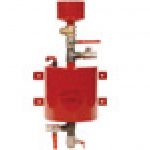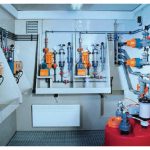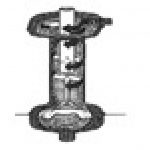Cleaning chemical ( neutral pH cleaners)
 Most chillers use water for heat transfer, so the water must be properly treated to prevent scale, corrosion and biological growth. A one-time chemical treatment is required for closed-water systems, which are typical of chilled-water systems connected to the chiller evaporator.
Most chillers use water for heat transfer, so the water must be properly treated to prevent scale, corrosion and biological growth. A one-time chemical treatment is required for closed-water systems, which are typical of chilled-water systems connected to the chiller evaporator.
Open systems typically are used for condenser-water systems connected to the chiller condenser. Condenser systems that use sources such as cooling towers require continuous chemical water treatment. Managers should work with a chemical-treatment vendor familiar with local water supplies and can provide full-service maintenance for all facility water systems.
Corrosion Inhibitor (Nitrate and Molybdate based)
 Most chillers use water for heat transfer, so the water must be properly treated to prevent scale, corrosion and biological growth. A one-time chemical treatment is required for closed-water systems, which are typical of chilled-water systems connected to the chiller evaporator.
Most chillers use water for heat transfer, so the water must be properly treated to prevent scale, corrosion and biological growth. A one-time chemical treatment is required for closed-water systems, which are typical of chilled-water systems connected to the chiller evaporator.
Open systems typically are used for condenser-water systems connected to the chiller condenser. Condenser systems that use sources such as cooling towers require continuous chemical water treatment. Managers should work with a chemical-treatment vendor familiar with local water supplies and can provide full-service maintenance for all facility water systems.
Micro Biocide
 Water Treatment Microbiocide is a synergistic blend of glutaraldehyde and quaternary ammonium salt which is specially formulated to provide a surface-active product that can clean and penetrate microbiologically-fouled surfaces. It is effective in controlling slime-forming and sulfate-reducing bacteria and algae. The ease of handling and high potency of Water Treatment Microbiocide facilitate its use in recirculating cooling towers, air washer systems, recirculating process water and closed loop cooling systems. It kills microbes such as bacteria, viruses, and fungi and used in disinfectant or antibacterial products.
Water Treatment Microbiocide is a synergistic blend of glutaraldehyde and quaternary ammonium salt which is specially formulated to provide a surface-active product that can clean and penetrate microbiologically-fouled surfaces. It is effective in controlling slime-forming and sulfate-reducing bacteria and algae. The ease of handling and high potency of Water Treatment Microbiocide facilitate its use in recirculating cooling towers, air washer systems, recirculating process water and closed loop cooling systems. It kills microbes such as bacteria, viruses, and fungi and used in disinfectant or antibacterial products.
Manual Dosing Pot
 Range of Dosing Pots for adding liquid chemicals such as corrosion inhibitors and anti freeze solutions – to sealed heating and chilled circuits. The Pot should be connected between the main flow and return pipes, with the flow in at the bottom (PF) to aid venting.
Range of Dosing Pots for adding liquid chemicals such as corrosion inhibitors and anti freeze solutions – to sealed heating and chilled circuits. The Pot should be connected between the main flow and return pipes, with the flow in at the bottom (PF) to aid venting.
Automatic Dosing System
 By the use of dosing systems the dosing task becomes increasingly easier. Pre-mounted complete solutions made by ProMinent are immediately available and ready for the use in important applications of dosage. Sensor technology, controllers and metering pumps form a unit with the necessary tanks and are ready for operation without installation work.
By the use of dosing systems the dosing task becomes increasingly easier. Pre-mounted complete solutions made by ProMinent are immediately available and ready for the use in important applications of dosage. Sensor technology, controllers and metering pumps form a unit with the necessary tanks and are ready for operation without installation work.
Dosing systems have three main advantages for the dosage of fluids compared to single components:
- Only one supplier and contact partner
- No interface problems between single components
- No own mounting works necessary. On demand, the whole system will be supplied as premounted and ready for operation or it will be commissioned by our technicians at the spot.
Our customers are provided a final solution that has only to be connected to hydraulic and electrical supply lines. On demand, even that will be effected by ProMinent.
All dosing systems are produced in our own factories, i.e. not only the main components such as metering pumps, controllers, sensor technology and tanks but also the mounting of the systems is effected from ProMinent staff. Thus ProMinent Quality is granted.
Side Stream filtration
 The most effective filter system for cooling towers and process water is a permanent media unit with side stream filtration. With side-stream filtration, a portion of the water filters continuously, while the whole system is filtered every hour. Side-stream filtration works on the principle that continuous particle removal will keep the system clean. The filtration goal is not to make drinking water but to remove the fine dirt, dust, smoke and organic particles that collect in water.
The most effective filter system for cooling towers and process water is a permanent media unit with side stream filtration. With side-stream filtration, a portion of the water filters continuously, while the whole system is filtered every hour. Side-stream filtration works on the principle that continuous particle removal will keep the system clean. The filtration goal is not to make drinking water but to remove the fine dirt, dust, smoke and organic particles that collect in water.
Flushing Operation
The CHILLED system will be flushed with a cleansing agent. Then when the entire agent is removed, a corrosion inhibitor will be added to the heating/chilled systems.
Rectifying dirty/ Turbid System
Test Kits
Lovibond Domestic Test Kits & Reagents
® Scale / Corrosion Inhibitor
Lovibond Domestic Test Kits & Reagents
® Micro Biocides
Products to control a broad spectrum of organic microorganisms
® Dispersant
When used appropriately, dispersants can be an effective method of response to an oil spill. They are capable of rapidly removing large amounts of certain oil types from the sea surface by transferring it into the water column.
® Decaling chemical
Heat exchanger treatment chemicals
® Automatic Dosing System
Prominnet dosing system
® Side Stream / Full Stream Filtration
The most effective filter system for cooling towers and process water is a permanent media unit with side stream filtration. With side-stream filtration, a portion of the water filters continuously, while the whole system is filtered every hour. Side-stream filtration works on the principle that continuous particle removal will keep the system clean. The filtration goal is not to make drinking water but to remove the fine dirt, dust, smoke and organic particles that collect in water.
® Flushing operation
The CHILLED system will be flushed with a cleansing agent. Then when the entire agent is removed, a corrosion inhibitor will be added to the heating/chilled systems.
® Cooling Towers
Mixed
® Test Kits
Lovibond Domestic Test Kits & Reagents
Oxygen Scavenger
Oxygen is a highly reactive gaseous element. In the presence of steel, the corrosion rate of oxygen doubles for each 30°F rise in temperature. For example, in a boiler system operating at 400 psig and 444°F, the corrosion rate for oxygen is 256 times more reactive than at room temperature. Oxygen forms localized corrosion areas referred to as “pits.” This distinctive formation is readily distinguishable from acid attack, caustic gouging or chelate corrosion Oxygen pits can rapidly “drill” through metal surfaces, leading to metal fatigue and failure.
Oxygen control is generally both a mechanical and chemical process. The majority of oxygen in the boiler feedwater is typically reduced to less than 20 parts per billion (ppb) by heating the water to reduce its solubility and releasing it out of the system via venting (deaeration). Since even very low levels of oxygen will cause corrosion, a chemical scavenger is used to supplement mechanical eaeration to reduce the level to zero.
Scale and Corrosion Inhibitor
The goal of any water treatment programme for a chilled water system is minimizing corrosion and prevention of metal loss and the formation of corrosion products.
The relatively low make-up to these systems makes this objective easily attainable. Once the corrosion inhibitor is added, it will passivate the metal surface and remain in the system, protecting it from further attack, therefore making high-level corrosion control possible at an economical cost.
Condensate line corrosion Inhibitor
Condensate is steam that has been returned to its liquid state. Steam, which is manufactured in the boiler, is used for various processes. After the steam is used, it is condensed to water and returns to the preboiler system through a series of pipes and condensate return equipment. Depending on the plant, the condensate system can be fairly small or very extensive in size.
As water returns to the boiler from plant processes that are distant from the boiler, contamination by process materials or leakage in the system can occur. Control of the condensate system is critical to the overall operation of the boiler. If the condensate system is not protected, corrosion results. Corrosion eats away at the metal in the pipes and equipment in the system. This can cause leaks in process equipment that can result in a process shutdown
pH Builder
pH Adjusters – our range of traditional and technically advanced boiler water treatment chemicals includes a number of pH adjusters. These high performance additives have been specifically developed for use across a range of process and industrial boiler treatment applications.
Antifoam
A defoamer or an anti-foaming agent is a chemical additive that reduces and hinders the formation of foam in industrial process liquids. The terms anti-foam agent and defoamer are often used interchangeably.
A defoamer is normally used in industrial processes to increase speed and reduce other problems. It addresses both problems with surface foam and entrained or entrapped air. A wide variety of chemical formulas are available to promote coalescence of foam.
Hydrazine dosing system
Hydrazin is a dosing system for the preparation and dosing of hydrazine solution. Hydracine is used as corrosion inhibitor in water and vapour systems. Due to its carcinogen effect, special preparation and metering plants are required. ProMinent DULCODOS® Hydrazin preparation and dosing systems are type-examination tested and approved by the government safety organization for the chemical industry.
Hydracine has a hydrogen binding effect, it is vapour volatile and encourages the formation of protectory films on steel surfaces. As hydracine is carcinogenic, its decanting and metering systems must be gas-proof so that no hydracine vapours can escape. Our systems come up to these requirements.
Dosing pumps for chemical feeding
Prominent pump details
Metering pumps are used wherever fluids must be dosed into a medium with a highest possible grade of accuracy with a defined volume and within a defined time period.
Automatic TDS and conductivity controllers
Prominent controllers
Automatic Blowdown Systems
Even with the best pretreatment programs, boiler feed water often contains some degree of impurities, such as suspended and dissolved solids. The impurities can remain and accumulate inside the boiler as the boiler operation continues. The increasing concentration of dissolved solids may lead to carryover of boiler water into the steam, causing damage to piping, steam traps and even process equipment. The increasing concentration of suspended solids can form sludge, which impairs boiler efficiency and heat transfer capability.
To avoid boiler problems, water must be periodically discharged or “blown down” from the boiler to control the concentrations of suspended and total dissolved solids in the boiler. Surface water blowdown is often done continuously to reduce the level of dissolved solids, and bottom blowdown is performed periodically to remove sludge from the bottom of the boiler.
The importance of boiler blowdown is often overlooked. Improper blowdown can cause increased fuel consumption, additional chemical treatment requirements, and heat loss. In addition, the blowdown water has the same temperature and pressure as the boiler water. This blowdown heat can be recovered and reused in the boiler operations.
Softener salt
Water softener salt is a product that removes ions from water that make water hard. Hard water refers to water with above average mineral content. This typically means calcium (Ca) and magnesium (Mg). Higher amounts of dissolved calcium and magnesium in water make the water less able to dissolve other solutes, such as soap. Hard water can also lead to clogged pipes due to increased lime scale build-ups. Lime scale build-ups make heating less efficient and produce more wear and tear on pipes and water dependent household machines, such as dishwashers and laundry machines.
Softener for Boiler feed water
Boiler Water Treatment – Continuing our look at steam boilers and boiler water treatment problems we look at issues that surround the accumulation of hardness salts and preventing scale in boiler systems. We examine the problems caused by the accumulation of scale, hardness salts and how to prevent them using equipment and specialist antiscalants and scale inhibitors.
Resins for Softner
The water softener resin is an integral, non-expendable part of a water softener.
In fact, it is the central factor that is crucial to the softening of what was once hard water so that it can be used by the household.
To summarize, the resin is responsible for removing the calcium and magnesium ions from the hard water. It also does the job of swapping sodium ions into the water that is now saturated of its calcium and magnesium ions.
The resin acts like a pseudo-filter that prevents the magnesium and calcium ions from remaining in the hard water that flows into the mineral tank.
a) Corrosion Inhibitor
The goal of any water treatment programme for a chilled water system is minimizing corrosion and prevention of metal loss and the formation of corrosion products.
The relatively low make-up to these systems makes this objective easily attainable. Once the corrosion inhibitor is added, it will passivate the metal surface and remain in the system, protecting it from further attack, therefore making high-level corrosion control possible at an economical cost.
Silicate / phosphate based
b) Disinfectant
® Automatic dosing system for chlorine and corrosion Inhibitor
Prominent pump details
® pH and chlorine measurement and control for potable water.
Prominent controller details
® Chlorine dioxide systems
Chlorine Dioxide generators provide an alternative method of disinfection to storage of bulk chlorine or pressurized chlorine gas. A chlorine dioxide generator utilizing an automated vacuum feed system minimizes the safety concerns ordinarily associated with storing and using bulk sodium hypochlorite, or chlorine gas.
® Ozone Generators
Ozone has been used for disinfection of drinking water in the Municipal Water Industry in Europe for over 100 years and is used by a large number of Water Companies, where ozone generator capacities in excess of 100 kg/h are common.
® Electrolytic chlorine Generators
This generator produces chlorine directly in to the pool or spa from a low concentration of salt added to the pool water. (The pool has salt added to it). Electrolysis takes place in an electrolytic cell installed “in-line” in the recirculation system. Thus the name. Inside the cell are layers of plates that are electrically charged by a separate power supply. Depending on the generator you need to maintain a salt concentration of about 2500-6000 parts per million in the pool or spa for the unit to operate effectively. This means adding 100-250 kg of salt per 40,000 litres of water.
® UV Sterilizers
The story of how ultraviolet (UV) light can guarantee safe drinking water is interesting. Many years ago scientists discovered that a special wavelength of UV light can kill disease-causing pathogens in our drinking water by attacking the cell DNA.
It was discovered that UV light can effectively destroy all common bacteria, viruses and spores which are regularly found in drinking water including E.coli, coliform, hepatitis, influenza, cholera, tuberculosis, legionella, salmonella, anthrax, cryptosporidium, giardia and many more. And UV light does all this without damaging our environment, and without any risk of overdose whatsoever.
Everyday we hear news of contaminated water supplies and boil-water orders being issued. How can you protect yourself and your family?
® Flow proportional dosing system
This Chemical Injection System controls the chemistry of some process fluids in order to reduce or to prevent corrosion or decomposition. Oxygen Scavenger is continuously injected into the feed-water stream in order to reduce the amount of 02 remaining downstream, the DE-aeration treatment of feed-water and into the condensate stream to reduce the corrosion problems. The scavenger solution is intermittently injected into the closed cooling water system by a common scavenger injection hardware. The dosing pumps are automatically controlled by a flow signal from the feed-water system and by residual 02 concentration signal. Ammonia is continuously injected into the condensate extraction pumps discharge. The dosing pumps are automatically controlled by a flow signal from the condensate system and by pH signal. Sodium Phosphate is injected to transform the silica content of the boiler water into Sodium Silicates. In case of raw water inlet into the condenser, Calcium and Magnesium salts are transformed into non-adherent precipitates.
® Polymer preparation and dosing system
CAP Series automatic polymer preparation system is designed for providing liquid polymer for continuous sludge dewatering equipment such as belt filter-press or decanter (centrifuge).
Four models available from production rate 750, 1500, 3000, 6000 liter/hour. CAP Series is completed with mixing tank, ageing tank, storage tank, stirrers, powder-hopper, screw-feeder, level electrodes, control panel and valves. CAP Series pre-wired and ready for use.
® Disinfectants
a. Calcium Hypochlorite ( granular)
Calcium hypochlorite is a chemical compound with formula Ca(ClO)2. It is widely used for water treatment and as a bleaching agent (bleaching powder). This chemical is considered to be relatively stable and has greater available chlorine than sodium hypochlorite (liquid bleach).
b. Stabilized chlorine (granular)
Chlorine stabilizer or conditioner (cyanuric acid) is used, in outdoor chlorine-maintained swimming pools, as a means of helping to protect the chlorine from being destroyed by the Sun’s ultra-violet rays.
Properly maintaining pool water chemistry is perhaps the most important aspect of maintaining a swimming pool. Proper water chemistry is required to keep a swimming pool safe and clean for swimmers. Maintaining a swimming pool’s chemicals can save pool owners hundreds of dollars per year, and endless hours of time. Armed with a basic understanding of swimming pool chemistry, and by following a few simple steps, any pool owner can maintain their own swimming pool with the same results as the high priced professionals.
d. Bromine Tablets
Bromine tablets slowly dissolve in water to provide active bromine sanitiser in the form of hypobromous acid. Also there is a chlorine content in the most commonly available tablets made from 1-bromo-3-chloro-5,5-dimethylhydantoin (Often abbreviated as BCDMH). This regenerates the hypbromous acid from bromine residues.
® pH Correction chemicals
Most chemical dosing systems, particularly when incorporated into wastewater and water treatment processes require a high degree of automation and control. Our expertise lies in providing clients with complete chemical dosing packages including quality dosing pumps, pH controllers, control systems and other accessories. Our specialty is the design and construction of skid mounted dosing equipment.
® Algaecides
An algaecide or algicide is a substance used for killing and preventing the growth of algae
® Flocculants and Coagulants
Coagulants and flocculant’s are formulated to assist in the solids/liquid separation of suspended particles in solution. Such particles are characteristically very small and the suspended stability of such particles (colloidal complex) is due to both their small size and to the electrical charge between particles. Conditioning a solution to promote the removal of suspended particles requires chemical coagulation and/or flocculation.
® Test Kits
6) CHEMICAL DOSING SYSTEMS
- Dosing pump and controller
- Automatic pH and chlorine dosing Systems
- Chemical Tanks
- Electrical and Manual Stirrers
- Automatic pH and Bromine System
1. pH meter
A pH meter is an electronic instrument used to measure the pH (acidity or alkalinity) of a liquid (though special probes are sometimes used to measure the pH of semi-solid substances). A typical pH meter consists of a special measuring probe (a glass electrode) connected to an electronic meter that measures and displays the pH reading
2. Conductivity meter
An electrical conductivity meter (EC meter) measures the electrical conductivity in a solution. Commonly used in hydroponics, aquaculture and freshwater systems to monitor the amount of nutrients, salts or impurities in the water.
3. Spectro Photometer
Spectrophotometry involves the use of a spectrophotometer. A spectrophotometer is a photometer (a device for measuring light intensity) that can measure intensity as a function of the color (or more specifically the wavelength) of light. Important features of spectrophotometers are spectral bandwidth and linear range of absorption measurement.
4. Turbidity Meter
Applications for the turbidity sensors include: water quality testing and management, river monitoring, stream measurement, reservoir water quality testing, groundwater testing, water and wastewater treatment, and effluent and industrial control.
5. BOD Measurement System
Biological Oxygen Demand (BOD) is an important parameter in water resource management. BOD is a parameter used to measure the quality of water and treatment results in wastewater. In addition, BOD analysis potential is used in the planning and design wastewater treatment facilities.
In routine use BOD determination is used to check the wastewater in the inflow and discharge of wastewater treatment plants. Depending on the measurement site and type of wastewater the BOD value can lie between a few mg/l and several thousand mg/l. Several methods are available for carrying out the measurement
6. Incubators
For checking presence of bacteria in water
7. COD Measurement System
In environmental chemistry, the chemical oxygen demand (COD) test is commonly used to indirectly measure the amount of organic compounds in water. Most applications of COD determine the amount of organic pollutants found in surface water (e.g. lakes and rivers), making COD a useful measure of water quality. It is expressed in milligrams per liter (mg/L), which indicates the mass of oxygen consumed per liter of solution. Older references may express the units as parts per million (ppm).
8. Mini test kits for Total Hardness, Alkalinity etc.
Water Hardness is a term used to express the concentration of predominantly calcium and magnesium ions in water. At sufficiently high concentrations hardness salts can precipitate, forming scale.
Our Water Hardess Test Kits can determine both calcium and magnesium concentrations, expressing results as mg/l CaCO3. Our range of drop tests, microburette tests and titrator tests allow for increasing accuracy in testing for hardness salts on-site.
9. Colour comparators for chlorine, pH, etc………
The method for determining the chlorine residual of drinking water by means of the chlorination kit was discussed in paragraph 2-9. This procedure is only an approximate method, because (1) it does not distinguish between free available chlorine (FAC) and combined available chlorine (CAC); (2) there are only three color standards (1.0, 5.0, and 10.0ppm) between which the observer must interpolate; and (3) there is no way to compensate for the natural color of the water. The color comparator, using the modified orthotolidine-sodium arsenite (OTA) method or N, N-diet’hyl-P-Phenyi-enediamine (DPD), will provide an accurate measure of the free available chlorine from 0.1 to 10 ppm and compensate for the natural color of the water. All readings should be taken within 1 minute
10. Hand held meter- Digital
11. Swimming pool test kits- Digital & Manual
12. Powder Pillows- test Reagents for chlorine, sulphate etc………
13. Filtration Units for Bacterial Tests
14. Bacterial filtration paper of 47 mm Dia 7 0.45 micron
15. SDI kit/ paper
16. Flock testers
17. Micron filtration (0.1 micron and above)
